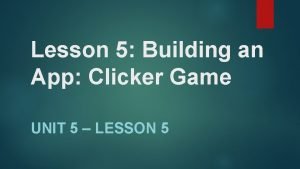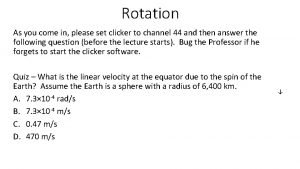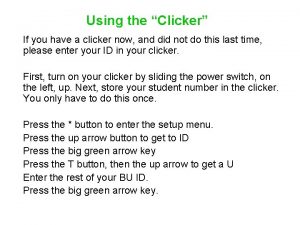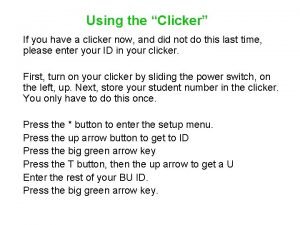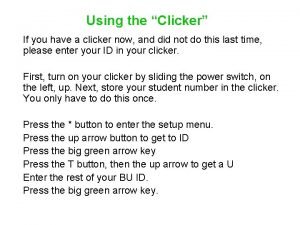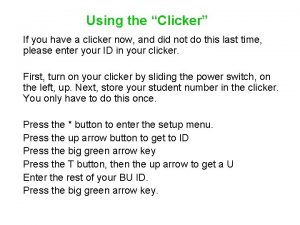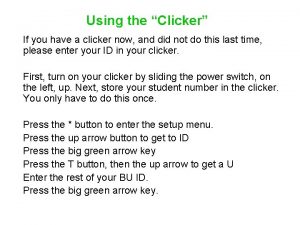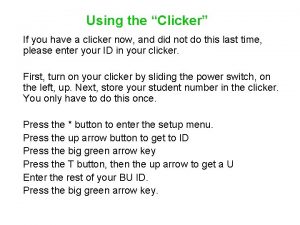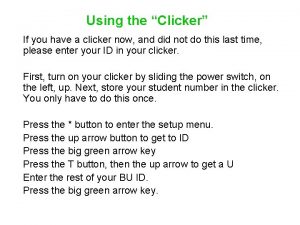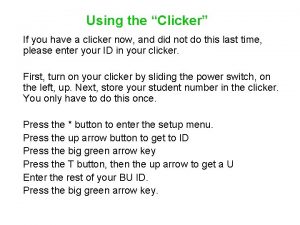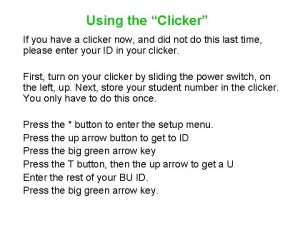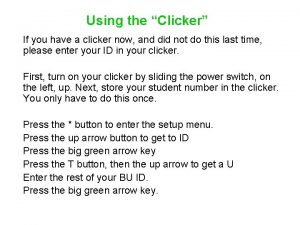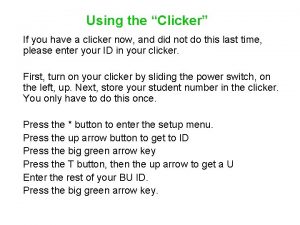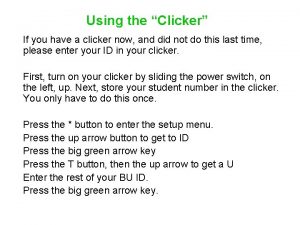Using the Clicker If you have a clicker














- Slides: 14

Using the “Clicker” If you have a clicker now, and did not do this last time, please enter your ID in your clicker. First, turn on your clicker by sliding the power switch, on the left, up. Next, store your student number in the clicker. You only have to do this once. Press the * button to enter the setup menu. Press the up arrow button to get to ID Press the big green arrow key Press the T button, then the up arrow to get a U Enter the rest of your BU ID. Press the big green arrow key.

Torque Forces can produce torques. The magnitude of a torque depends on the force, the direction of the force, and where the force is applied. The magnitude of the torque is. is measured from the axis of rotation to the line of the force, and is the angle between and. To find the direction of a torque from a force, pin the object at the axis of rotation and push on it with the force. We can say that the torque from that force is whichever direction the object spins (counterclockwise, in the picture above). Torque is zero when and are along the same line. Torque is maximum when and are perpendicular.

Three ways to find torque Find the torque applied by the string on the rod. 1. Just apply the equation

Three ways to find torque Find the torque applied by the string on the rod. 2. Break the force into components first, then use The force component along the rod gives no torque. .

Three ways to find torque Find the torque applied by the string on the rod. 3. Use the lever-arm method: measure r along the line that meets the line of the force at a 90° angle.

Worksheet, part 2 Try drawing a free-body diagram for a horizontal rod that is hinged at one end. The rod is held horizontal by an upward force applied by a spring scale ¼ of the way along the rod. How does the weight of the rod compare to the reading on the spring scale? An equilibrium example This is a model of our lower arm, with the elbow being the hinge.

Summing the torques To solve for the unknown force, we can’t use forces, because we get one equation with two unknowns (the force of gravity and the hinge force). Use torques instead. We can take torques about any axis we want, but if we take torques about an axis through the hinge we eliminate the unknown hinge force. Define clockwise as positive, and say the rod has a length L.

Equilibrium For an object to remain in equilibrium, two conditions must be met. The object must have no net force: and no net torque:

Moving the spring scale What, if anything, happens when the spring scale is moved farther away from the hinge? To maintain equilibrium: 1. The magnitude of the spring-scale force increases. 2. The magnitude of the spring-scale force decreases. 3. The magnitude of the downward hinge force increases. 4. The magnitude of the downward hinge force decreases. 5. Both 1 and 3 6. Both 1 and 4 7. Both 2 and 3 8. Both 2 and 4 9. None of the above.

Red and blue rods Two rods of the same shape are held at their centers and rotated back and forth. The red one is much easier to rotate than the blue one. What is the best possible explanation for this? 1. The red one has more mass. 2. The blue one has more mass. 3. The red one has its mass concentrated more toward the center; the blue one has its mass concentrated more toward the ends. 4. The blue one has its mass concentrated more toward the center; the red one has its mass concentrated more toward the ends. 5. Either 1 or 3 6. Either 1 or 4 7. Either 2 or 3 8. Either 2 or 4 9. Due to the nature of light, red objects are just inherently easier to spin than blue objects are.

Newton’s First Law for Rotation An object at rest tends to remain at rest, and an object that is spinning tends to spin with a constant angular velocity, unless it is acted on by a nonzero net torque or there is a change in the way the object's mass is distributed. The net torque is the vector sum of all the torques acting on an object. The tendency of an object to maintain its state of motion is known as inertia. For straight-line motion mass is the measure of inertia, but mass by itself is not enough to define rotational inertia.

Rotational Inertia How hard it is to get something to spin, or to change an object's rate of spin, depends on the mass, and on how the mass is distributed relative to the axis of rotation. Rotational inertia, or moment of inertia, accounts for all these factors. The moment of inertia, I, is the rotational equivalent of mass. For an object like a ball on a string, where all the mass is the same distance away from the axis of rotation: If the mass is distributed at different distances from the rotation axis, the moment of inertia can be hard to calculate. It's much easier to look up expressions for I from the table on page 291 in the book (page 10 -15 in Essential Physics).

A table of rotational inertias

Whiteboard
 Samuel they have rejected me
Samuel they have rejected me It has 6 rectangular faces 8 corners and 12 edges
It has 6 rectangular faces 8 corners and 12 edges Mathclicker
Mathclicker E clicker
E clicker Turning point audience response
Turning point audience response Lesson 5 building an app clicker game
Lesson 5 building an app clicker game Earth clicker
Earth clicker Heart rate clicker
Heart rate clicker Japan movie rape
Japan movie rape Clicker stop motion
Clicker stop motion Cooi clicker
Cooi clicker Umbc clicker
Umbc clicker Clicker box
Clicker box Youtube youtube
Youtube youtube Clicker stop motion
Clicker stop motion





